Chenyang Gu
RoboMIND 2.0: A Multimodal, Bimanual Mobile Manipulation Dataset for Generalizable Embodied Intelligence
Dec 31, 2025Abstract:While data-driven imitation learning has revolutionized robotic manipulation, current approaches remain constrained by the scarcity of large-scale, diverse real-world demonstrations. Consequently, the ability of existing models to generalize across long-horizon bimanual tasks and mobile manipulation in unstructured environments remains limited. To bridge this gap, we present RoboMIND 2.0, a comprehensive real-world dataset comprising over 310K dual-arm manipulation trajectories collected across six distinct robot embodiments and 739 complex tasks. Crucially, to support research in contact-rich and spatially extended tasks, the dataset incorporates 12K tactile-enhanced episodes and 20K mobile manipulation trajectories. Complementing this physical data, we construct high-fidelity digital twins of our real-world environments, releasing an additional 20K-trajectory simulated dataset to facilitate robust sim-to-real transfer. To fully exploit the potential of RoboMIND 2.0, we propose MIND-2 system, a hierarchical dual-system frame-work optimized via offline reinforcement learning. MIND-2 integrates a high-level semantic planner (MIND-2-VLM) to decompose abstract natural language instructions into grounded subgoals, coupled with a low-level Vision-Language-Action executor (MIND-2-VLA), which generates precise, proprioception-aware motor actions.
Scaling Spatial Intelligence with Multimodal Foundation Models
Nov 17, 2025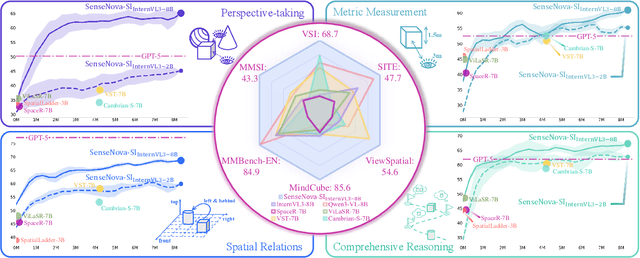
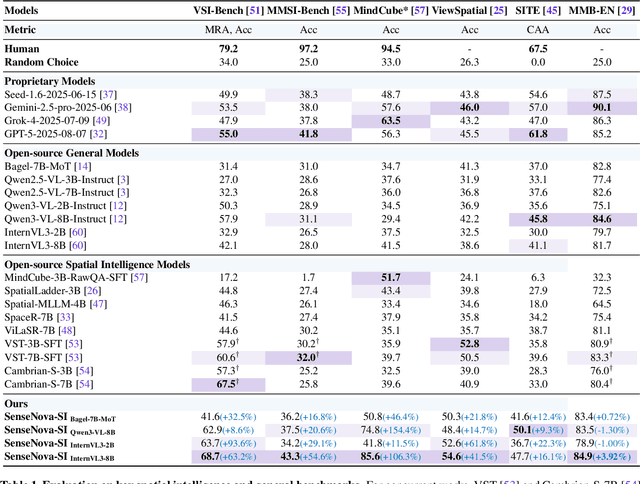
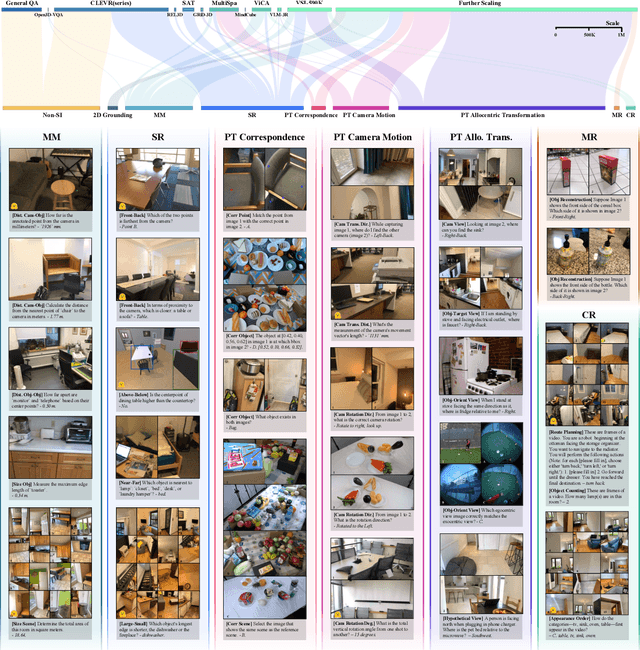
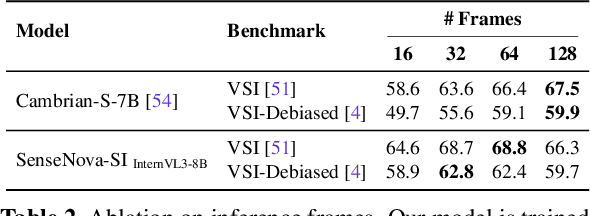
Abstract:Despite remarkable progress, multimodal foundation models still exhibit surprising deficiencies in spatial intelligence. In this work, we explore scaling up multimodal foundation models to cultivate spatial intelligence within the SenseNova-SI family, built upon established multimodal foundations including visual understanding models (i.e., Qwen3-VL and InternVL3) and unified understanding and generation models (i.e., Bagel). We take a principled approach to constructing high-performing and robust spatial intelligence by systematically curating SenseNova-SI-8M: eight million diverse data samples under a rigorous taxonomy of spatial capabilities. SenseNova-SI demonstrates unprecedented performance across a broad range of spatial intelligence benchmarks: 68.7% on VSI-Bench, 43.3% on MMSI, 85.6% on MindCube, 54.6% on ViewSpatial, and 50.1% on SITE, while maintaining strong general multimodal understanding (e.g., 84.9% on MMBench-En). More importantly, we analyze the impact of data scaling, discuss early signs of emergent generalization capabilities enabled by diverse data training, analyze the risk of overfitting and language shortcuts, present a preliminary study on spatial chain-of-thought reasoning, and validate the potential downstream application. SenseNova-SI is an ongoing project, and this report will be updated continuously. All newly trained multimodal foundation models are publicly released to facilitate further research in this direction.
Causal Inspired Multi Modal Recommendation
Oct 14, 2025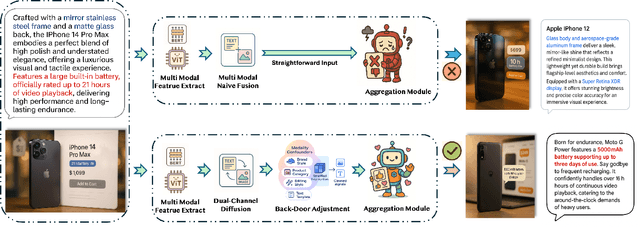
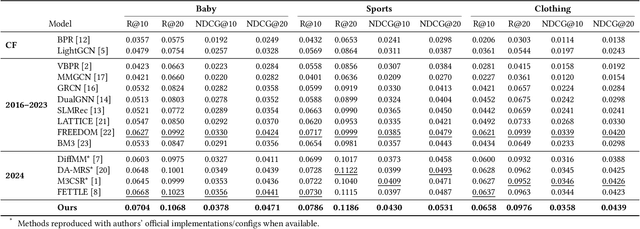


Abstract:Multimodal recommender systems enhance personalized recommendations in e-commerce and online advertising by integrating visual, textual, and user-item interaction data. However, existing methods often overlook two critical biases: (i) modal confounding, where latent factors (e.g., brand style or product category) simultaneously drive multiple modalities and influence user preference, leading to spurious feature-preference associations; (ii) interaction bias, where genuine user preferences are mixed with noise from exposure effects and accidental clicks. To address these challenges, we propose a Causal-inspired multimodal Recommendation framework. Specifically, we introduce a dual-channel cross-modal diffusion module to identify hidden modal confounders, utilize back-door adjustment with hierarchical matching and vector-quantized codebooks to block confounding paths, and apply front-door adjustment combined with causal topology reconstruction to build a deconfounded causal subgraph. Extensive experiments on three real-world e-commerce datasets demonstrate that our method significantly outperforms state-of-the-art baselines while maintaining strong interpretability.
MLA: A Multisensory Language-Action Model for Multimodal Understanding and Forecasting in Robotic Manipulation
Sep 30, 2025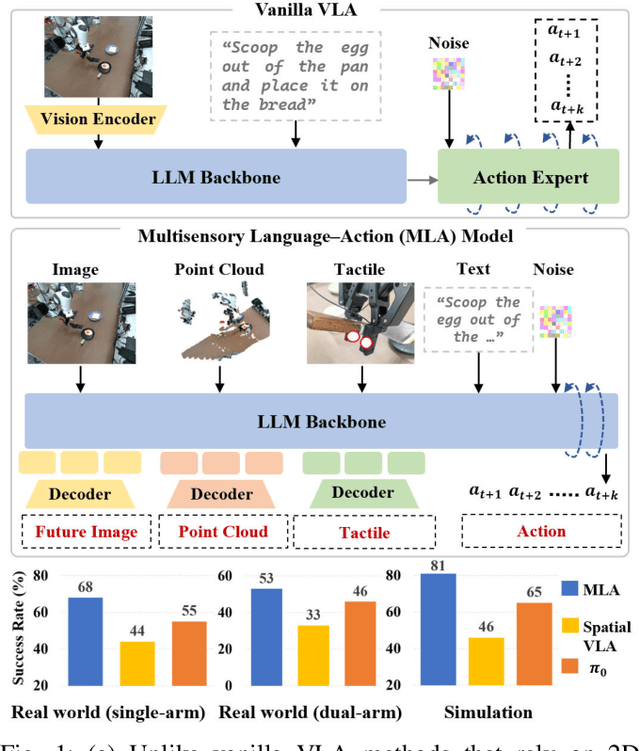
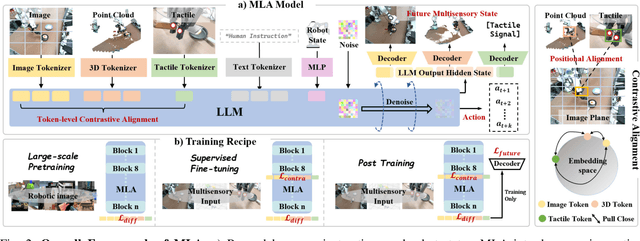

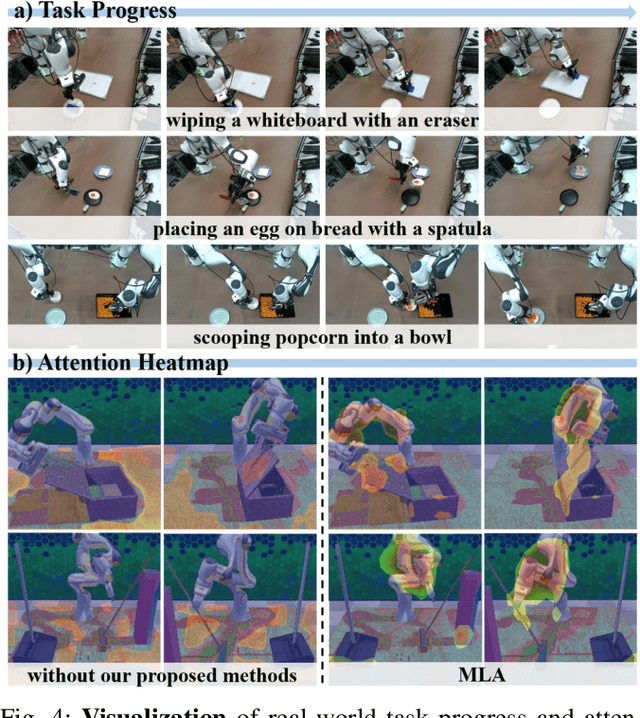
Abstract:Vision-language-action models (VLAs) have shown generalization capabilities in robotic manipulation tasks by inheriting from vision-language models (VLMs) and learning action generation. Most VLA models focus on interpreting vision and language to generate actions, whereas robots must perceive and interact within the spatial-physical world. This gap highlights the need for a comprehensive understanding of robotic-specific multisensory information, which is crucial for achieving complex and contact-rich control. To this end, we introduce a multisensory language-action (MLA) model that collaboratively perceives heterogeneous sensory modalities and predicts future multisensory objectives to facilitate physical world modeling. Specifically, to enhance perceptual representations, we propose an encoder-free multimodal alignment scheme that innovatively repurposes the large language model itself as a perception module, directly interpreting multimodal cues by aligning 2D images, 3D point clouds, and tactile tokens through positional correspondence. To further enhance MLA's understanding of physical dynamics, we design a future multisensory generation post-training strategy that enables MLA to reason about semantic, geometric, and interaction information, providing more robust conditions for action generation. For evaluation, the MLA model outperforms the previous state-of-the-art 2D and 3D VLA methods by 12% and 24% in complex, contact-rich real-world tasks, respectively, while also demonstrating improved generalization to unseen configurations. Project website: https://sites.google.com/view/open-mla
Has GPT-5 Achieved Spatial Intelligence? An Empirical Study
Aug 18, 2025Abstract:Multi-modal models have achieved remarkable progress in recent years. Nevertheless, they continue to exhibit notable limitations in spatial understanding and reasoning, which are fundamental capabilities to achieving artificial general intelligence. With the recent release of GPT-5, allegedly the most powerful AI model to date, it is timely to examine where the leading models stand on the path toward spatial intelligence. First, we propose a comprehensive taxonomy of spatial tasks that unifies existing benchmarks and discuss the challenges in ensuring fair evaluation. We then evaluate state-of-the-art proprietary and open-source models on eight key benchmarks, at a cost exceeding one billion total tokens. Our empirical study reveals that (1) GPT-5 demonstrates unprecedented strength in spatial intelligence, yet (2) still falls short of human performance across a broad spectrum of tasks. Moreover, we (3) identify the more challenging spatial intelligence problems for multi-modal models, and (4) proprietary models do not exhibit a decisive advantage when facing the most difficult problems. In addition, we conduct a qualitative evaluation across a diverse set of scenarios that are intuitive for humans yet fail even the most advanced multi-modal models.
AC-DiT: Adaptive Coordination Diffusion Transformer for Mobile Manipulation
Jul 02, 2025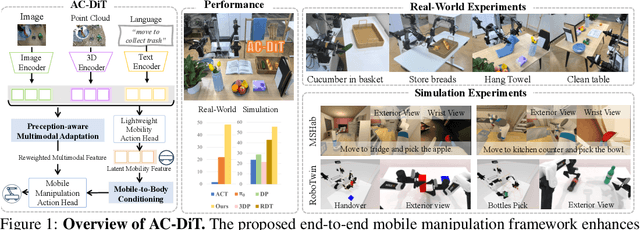
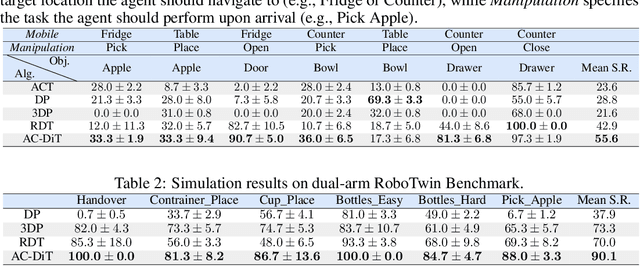
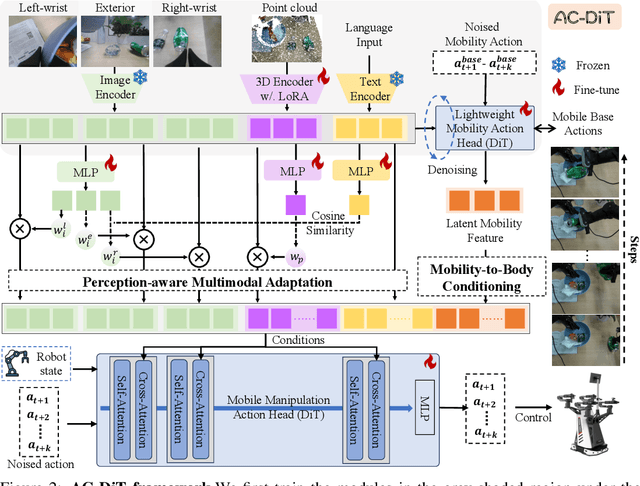

Abstract:Recently, mobile manipulation has attracted increasing attention for enabling language-conditioned robotic control in household tasks. However, existing methods still face challenges in coordinating mobile base and manipulator, primarily due to two limitations. On the one hand, they fail to explicitly model the influence of the mobile base on manipulator control, which easily leads to error accumulation under high degrees of freedom. On the other hand, they treat the entire mobile manipulation process with the same visual observation modality (e.g., either all 2D or all 3D), overlooking the distinct multimodal perception requirements at different stages during mobile manipulation. To address this, we propose the Adaptive Coordination Diffusion Transformer (AC-DiT), which enhances mobile base and manipulator coordination for end-to-end mobile manipulation. First, since the motion of the mobile base directly influences the manipulator's actions, we introduce a mobility-to-body conditioning mechanism that guides the model to first extract base motion representations, which are then used as context prior for predicting whole-body actions. This enables whole-body control that accounts for the potential impact of the mobile base's motion. Second, to meet the perception requirements at different stages of mobile manipulation, we design a perception-aware multimodal conditioning strategy that dynamically adjusts the fusion weights between various 2D visual images and 3D point clouds, yielding visual features tailored to the current perceptual needs. This allows the model to, for example, adaptively rely more on 2D inputs when semantic information is crucial for action prediction, while placing greater emphasis on 3D geometric information when precise spatial understanding is required. We validate AC-DiT through extensive experiments on both simulated and real-world mobile manipulation tasks.
HybridVLA: Collaborative Diffusion and Autoregression in a Unified Vision-Language-Action Model
Mar 13, 2025Abstract:Recent advancements in vision-language models (VLMs) for common-sense reasoning have led to the development of vision-language-action (VLA) models, enabling robots to perform generalized manipulation. Although existing autoregressive VLA methods leverage large-scale pretrained knowledge, they disrupt the continuity of actions. Meanwhile, some VLA methods incorporate an additional diffusion head to predict continuous actions, relying solely on VLM-extracted features, which limits their reasoning capabilities. In this paper, we introduce HybridVLA, a unified framework that seamlessly integrates the strengths of both autoregressive and diffusion policies within a single large language model, rather than simply connecting them. To bridge the generation gap, a collaborative training recipe is proposed that injects the diffusion modeling directly into the next-token prediction. With this recipe, we find that these two forms of action prediction not only reinforce each other but also exhibit varying performance across different tasks. Therefore, we design a collaborative action ensemble mechanism that adaptively fuses these two predictions, leading to more robust control. In experiments, HybridVLA outperforms previous state-of-the-art VLA methods across various simulation and real-world tasks, including both single-arm and dual-arm robots, while demonstrating stable manipulation in previously unseen configurations.
SliceOcc: Indoor 3D Semantic Occupancy Prediction with Vertical Slice Representation
Jan 28, 2025



Abstract:3D semantic occupancy prediction is a crucial task in visual perception, as it requires the simultaneous comprehension of both scene geometry and semantics. It plays a crucial role in understanding 3D scenes and has great potential for various applications, such as robotic vision perception and autonomous driving. Many existing works utilize planar-based representations such as Bird's Eye View (BEV) and Tri-Perspective View (TPV). These representations aim to simplify the complexity of 3D scenes while preserving essential object information, thereby facilitating efficient scene representation. However, in dense indoor environments with prevalent occlusions, directly applying these planar-based methods often leads to difficulties in capturing global semantic occupancy, ultimately degrading model performance. In this paper, we present a new vertical slice representation that divides the scene along the vertical axis and projects spatial point features onto the nearest pair of parallel planes. To utilize these slice features, we propose SliceOcc, an RGB camera-based model specifically tailored for indoor 3D semantic occupancy prediction. SliceOcc utilizes pairs of slice queries and cross-attention mechanisms to extract planar features from input images. These local planar features are then fused to form a global scene representation, which is employed for indoor occupancy prediction. Experimental results on the EmbodiedScan dataset demonstrate that SliceOcc achieves a mIoU of 15.45% across 81 indoor categories, setting a new state-of-the-art performance among RGB camera-based models for indoor 3D semantic occupancy prediction. Code is available at https://github.com/NorthSummer/SliceOcc.
RoboMIND: Benchmark on Multi-embodiment Intelligence Normative Data for Robot Manipulation
Dec 18, 2024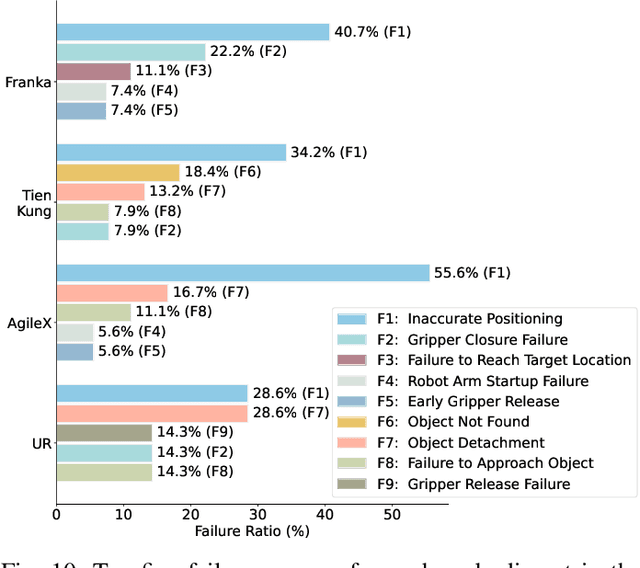
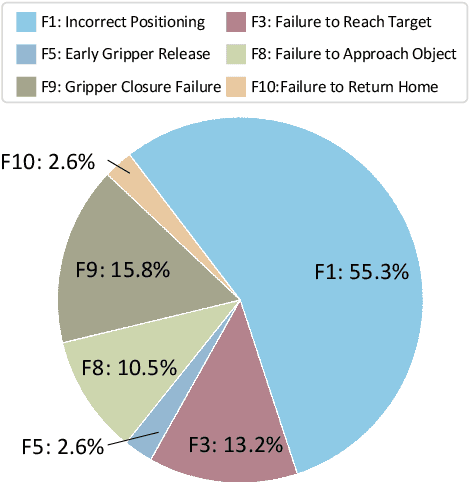
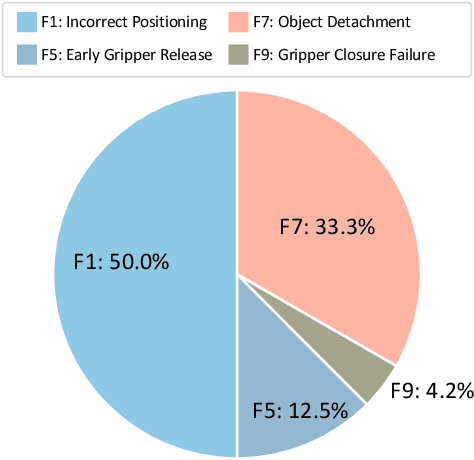
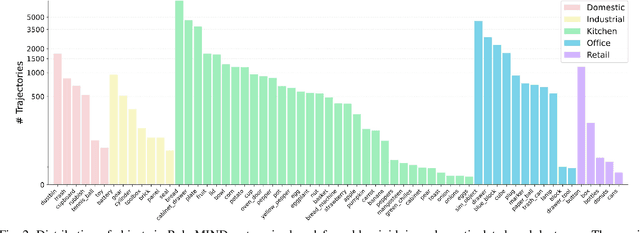
Abstract:Developing robust and general-purpose robotic manipulation policies is a key goal in the field of robotics. To achieve effective generalization, it is essential to construct comprehensive datasets that encompass a large number of demonstration trajectories and diverse tasks. Unlike vision or language data that can be collected from the Internet, robotic datasets require detailed observations and manipulation actions, necessitating significant investment in hardware-software infrastructure and human labor. While existing works have focused on assembling various individual robot datasets, there remains a lack of a unified data collection standard and insufficient diversity in tasks, scenarios, and robot types. In this paper, we introduce RoboMIND (Multi-embodiment Intelligence Normative Data for Robot manipulation), featuring 55k real-world demonstration trajectories across 279 diverse tasks involving 61 different object classes. RoboMIND is collected through human teleoperation and encompasses comprehensive robotic-related information, including multi-view RGB-D images, proprioceptive robot state information, end effector details, and linguistic task descriptions. To ensure dataset consistency and reliability during policy learning, RoboMIND is built on a unified data collection platform and standardized protocol, covering four distinct robotic embodiments. We provide a thorough quantitative and qualitative analysis of RoboMIND across multiple dimensions, offering detailed insights into the diversity of our datasets. In our experiments, we conduct extensive real-world testing with four state-of-the-art imitation learning methods, demonstrating that training with RoboMIND data results in a high manipulation success rate and strong generalization. Our project is at https://x-humanoid-robomind.github.io/.
Lift3D Foundation Policy: Lifting 2D Large-Scale Pretrained Models for Robust 3D Robotic Manipulation
Nov 27, 2024



Abstract:3D geometric information is essential for manipulation tasks, as robots need to perceive the 3D environment, reason about spatial relationships, and interact with intricate spatial configurations. Recent research has increasingly focused on the explicit extraction of 3D features, while still facing challenges such as the lack of large-scale robotic 3D data and the potential loss of spatial geometry. To address these limitations, we propose the Lift3D framework, which progressively enhances 2D foundation models with implicit and explicit 3D robotic representations to construct a robust 3D manipulation policy. Specifically, we first design a task-aware masked autoencoder that masks task-relevant affordance patches and reconstructs depth information, enhancing the 2D foundation model's implicit 3D robotic representation. After self-supervised fine-tuning, we introduce a 2D model-lifting strategy that establishes a positional mapping between the input 3D points and the positional embeddings of the 2D model. Based on the mapping, Lift3D utilizes the 2D foundation model to directly encode point cloud data, leveraging large-scale pretrained knowledge to construct explicit 3D robotic representations while minimizing spatial information loss. In experiments, Lift3D consistently outperforms previous state-of-the-art methods across several simulation benchmarks and real-world scenarios.
 Add to Chrome
Add to Chrome Add to Firefox
Add to Firefox Add to Edge
Add to Edge